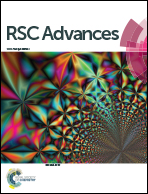Taming the polysulphide shuttle in Li–S batteries by plasma-induced asymmetric functionalisation of the separator†
Abstract
A novel microporous separator for lithium–sulphur batteries, in the form of an asymmetric membrane with cation-exchange functional groups, was synthesised by a one-step plasma-induced graft co-polymerisation. This separator consists of commercial porous polypropylene modified with styrene sulfonate at or near the surface of the material. Both successful grafting and membrane asymmetry were confirmed by attenuated total reflectance Fourier transform infrared spectroscopy. Morphological changes as a function of graft level were analysed using scanning electron microscopy. Additionally, the separators were tested for their ability to inhibit polysulphide diffusion, which showed a strong dependence on the amount of negatively charged –SO3− groups introduced onto the hydrophobic substrate. Cycling tests in model Li–S cells with the modified separators showed improved coulombic efficiency.


 Please wait while we load your content...
Please wait while we load your content...